The Surface 3 Review
by Brett Howse on May 4, 2015 9:00 AM ESTGPU Performance
The Surface 3 with the Atom x7-Z8700 pairs the Intel Gen 8 Graphics from Broadwell with the Airmont CPU cores of Atom. Unlike the Broadwell cores though, the Surface 3 SoC only has 16 execution units (EUs) as compared to 24 in Core M. The maximum frequency is also reduced to 600 MHz for these cores, as compared to up to 900 MHz in Core M. This is all necessary to keep the x7-8700 in the 2 watt SDP.
So performance will be a step back compared to Core M, but really this should be no surprise. The interesting comparison will be how it compares to Surface Pro 3 with Haswell Gen 7.5 graphics and of course to Bay Trail equipped tablets.
We will start with some synthetic tests and then move on to DOTA 2 to see how it performs on a real world game.
3DMark Tablet
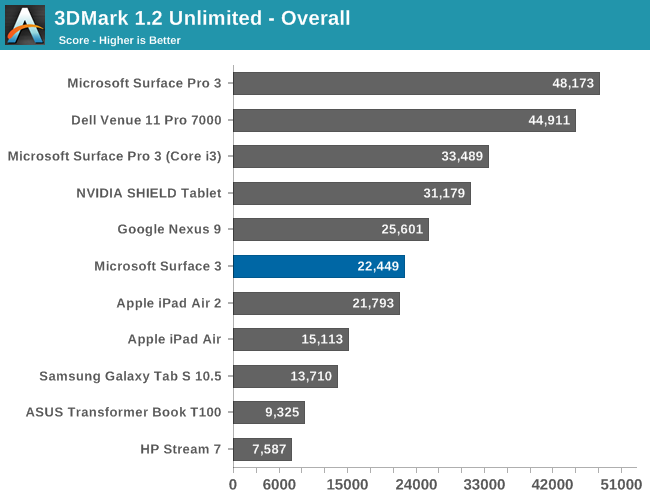


The GPU upgrade is a big improvement over the ASUS T100's Bay Trail graphics, but the Atom GPU still can not compete with the fastest tablet SoCs out there.
3DMark Notebook
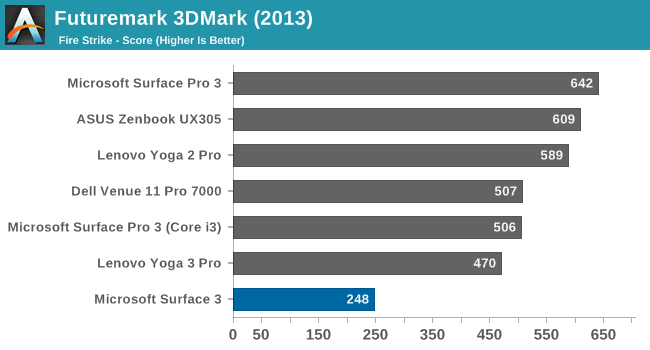
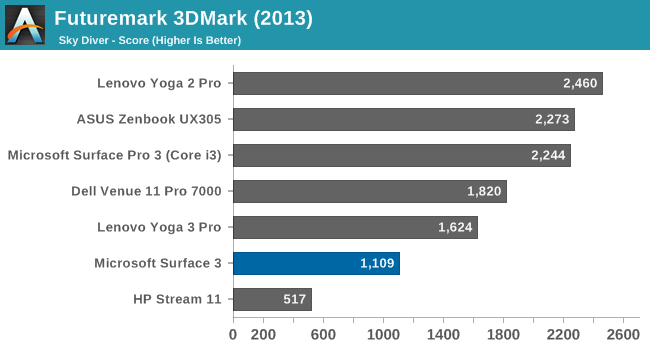
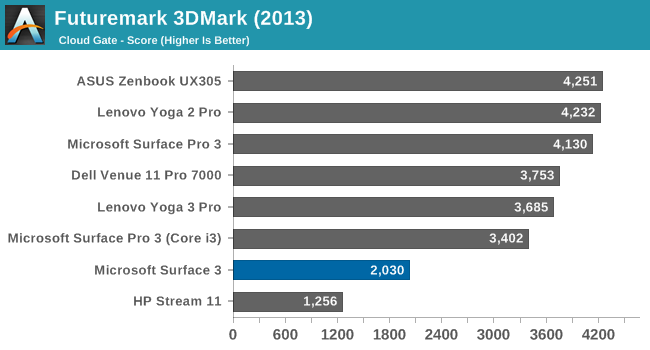

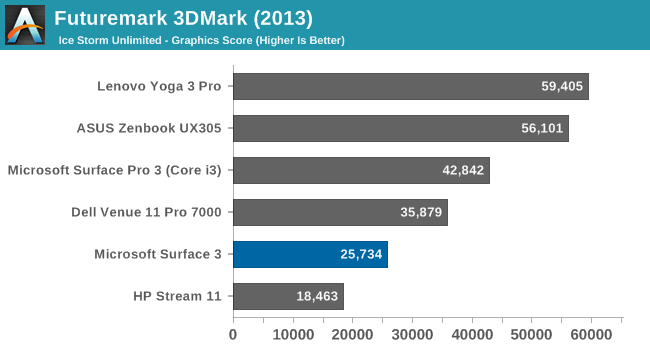
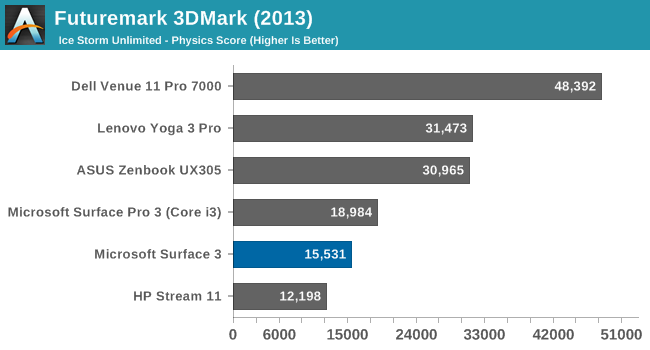
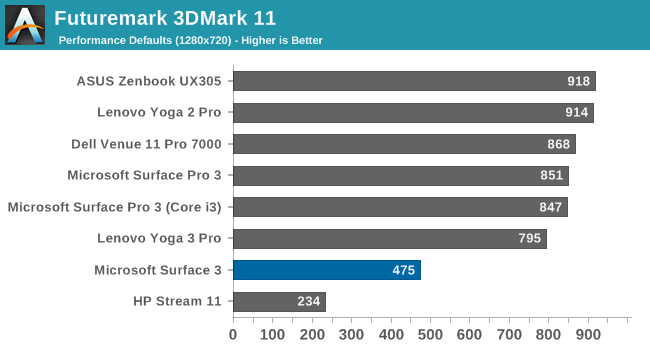
Comparing the Surface 3 to PC class hardware puts it in a pretty poor light when looking at GPU performance. Our 3DMark tests have the Surface Pro 3 with the Core i3 on average 40% faster than Surface 3. Comparing it to the Dell Venue 11 Pro with Core M, we find the Core M GPU is on average 47% faster, which is quite a gap. Let’s not forget though that the Surface 3 is a mere 2 watt SDP, whereas Core M is a 4.5 W TDP and the Haswell-Y in Surface Pro 3 is an 11.5 W TDP.
GFXBench Tablet (OpenGL)
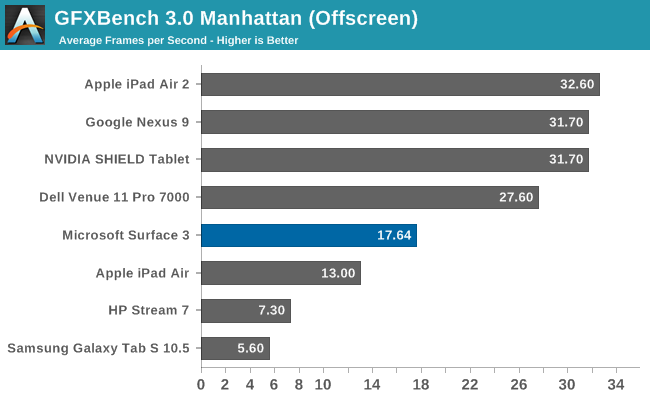
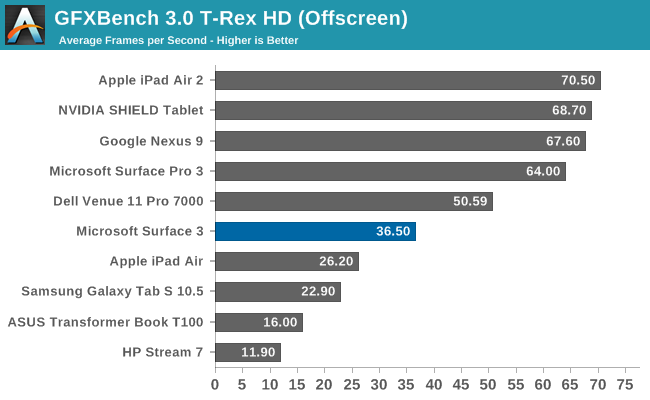
As with the 3DMark scores, the GPU upgrade is significant, but still a ways back of the best tablet GPUs out there. Intel still has some work to do on this front.
GFXBench Notebook (DirectX)
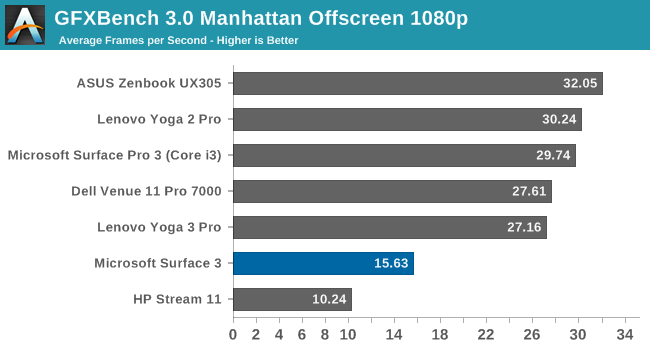
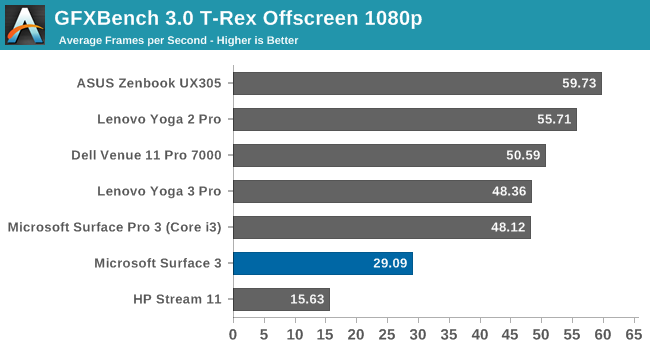
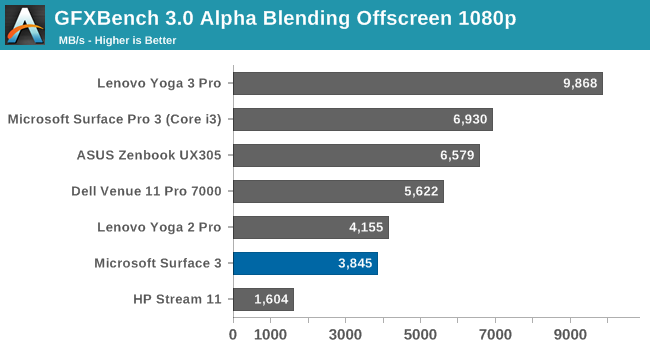

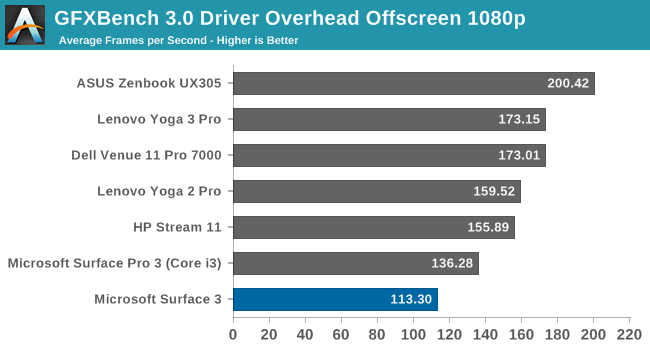
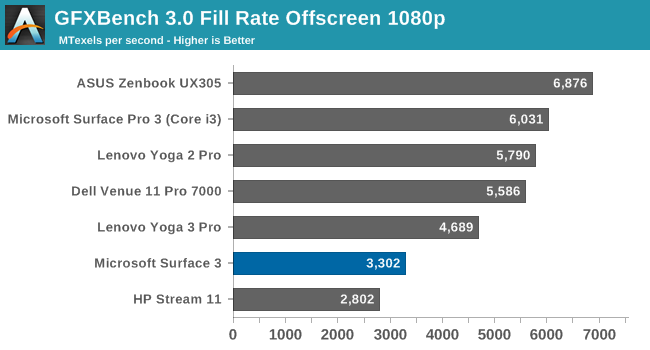

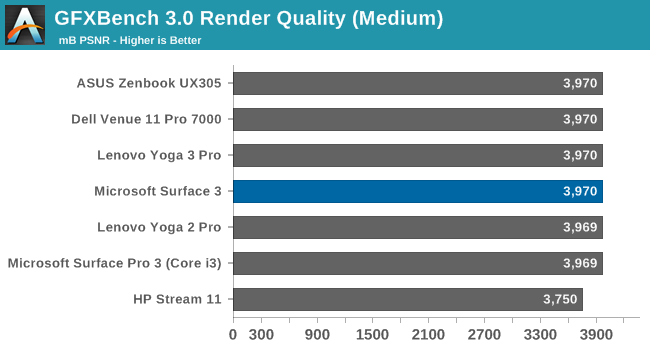
We see a similar story with GFXBench on the notebook side. The 16 EUs in our Atom SoC just cannot compete against the larger and faster GPUs in Core.
Moving on to a real-world game, we use a custom DOTA 2 benchmark for our lower powered devices. It is a very popular battle-arena game, and the GPU requirements are not too demanding.
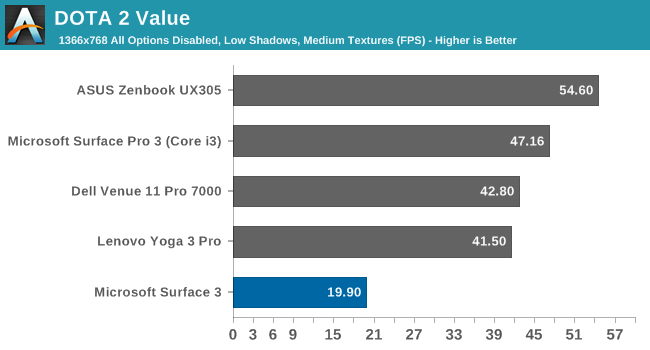
The GPU in the Surface 3 is really not enough to play most games, and even on our value settings, the Surface 3 is not a great experience for DOTA 2. The higher TDP of Core M lets it do ok in this test, but overall the Surface 3 is a long way back of even the Surface Pro 3 Core i3.
Storage Performance
Like most tablets, the Surface 3 utilizes eMMC storage rather than the SSD storage found on higher priced laptops and Core M tablets. It costs less, it is less complex, and it works. So expectations are that it will not be able to compete with the fastest solutions out there. But as a tablet, workloads should be less complex, at least in theory.
Unfortunately Microsoft shipped me the 64 GB version of the tablet, and due to PCMark 8 requiring a large amount of free space in order to perform its tests, it was unable to be run on this device. But we have run into this issue in the past, and we can turn to a couple of other tools to get a feel for how the storage performance is. Even though eMMC is slower than a good SSD, there is still different levels of performance based on the NAND in use and the controller.
I ran CrystalDiskMark over a 4 GB span and the results are below.
Surface 3 eMMC Storage (left) vs Surface Pro 3 Core i3 SSD (right)
Compared to a true SSD, the eMMC performance leaves a lot to be desired. In fact, most of the time when I was using the tablet and I found it slow, such as installing software, or loading programs, it was mostly disk bound. There are faster eMMC options available, but I will refrain from comparing it to other tablets since we do not have the same benchmarking tools for both.


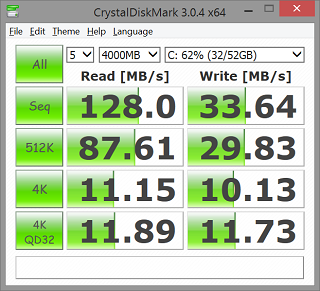
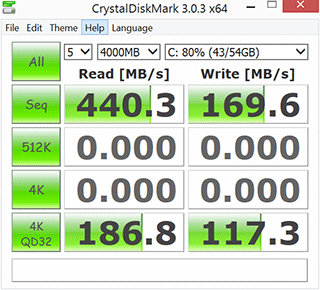








265 Comments
View All Comments
nikon133 - Monday, May 4, 2015 - link
Very inclined to finally replace my old ThinkPad Tablet 2 with Surface 3.Better battery life would be good, but close to 8 hours of tablet-mode browsing and video watching should do.
In addition, I love how kickstand works on SP3 and it's presence - even in simplified form - makes big difference for me. Looking at scores, this might even be able to handle some light Lightroom work - the most demanding task I have for my laptop at present - so it could fully integrate my tablet and laptop needs, leaving me with tablet and desktop only. One device less to update, charge, maintain, buy in a first place - sounds good to me.
Novacius - Monday, May 4, 2015 - link
In my opinion, it's too heavy compared to a iPad Air 2 or so. And it's too expensive: Its starts at 599€ in Germany, the Pro variant only costs 90€ more.damianrobertjones - Wednesday, May 6, 2015 - link
Then people moving from the Ipad 4 will be more than happy with the S3kyuu - Monday, May 4, 2015 - link
Thanks for the review, Brett. No more nagging from me. ;)The one thing I am missing is the Dolphin benchmark. Were you unable to run that?
As far as the S3 itself goes; while I cancelled my preorder for it, I only did so because I was able to get a good deal on a Core i5 SP3 on ebay. For the price, it's still a lot more capable than a comparably priced iPad, and I wouldn't have been sorry to have it. And iPads still don't have a built-in way to prop themselves up, which I consider an indispensable feature nowadays. I am disappointed that the storage is a bit on the slow side given that we have some pretty fast eMMC (not to mention UFS) nowadays. And the battery life results are a bit worrisome.
metayoshi - Monday, May 4, 2015 - link
Dolphin benchmark on this thing? Believe me when I say this, my old Core i7-860 couldn't run Dolphin that well, save for a very few select games, and it's one of the reasons I upgraded to a Core i7-4790K last September. The Atom x7-z8700 is nowhere near the performance of the Core i7-860, and much is closer to the Core 2 Duo SU-7300 that was in the Asus UL30Vt that I had around the same time I built my Core i7-860 in early 2010. There's no question, this thing will suck running the Dolphin benchmark.I'm actually getting a Surface 3 myself, but it's definitely not for running the Dolphin emulator.
NA1NSXR - Monday, May 4, 2015 - link
This was the tablet I was waiting for, except it isn't. The choice of Atom over Core M is unacceptable to me, so as hard it was to wait for an iPad-sized device to bring full Windows, I will have to pass.kyuu - Monday, May 4, 2015 - link
If this had Core M, the price would barely be less than a Surface Pro.damianrobertjones - Wednesday, May 6, 2015 - link
Core m? You do know that the Lenovo Yoga devices, with Core M, have a fan! You might as well just go for the Pro 3.zodiacfml - Tuesday, May 5, 2015 - link
Nice, but its kinda bit late considering laptops based on the Core M have been getting thinner and quite reasonable in cost especially the Asus.Or is it just pricing, for the price without the keyboard it is pricey even with the good display.
I can only see this good for business or work where a tablet is being used for business/company software.
meacupla - Tuesday, May 5, 2015 - link
There's really one big difference between microsoft and asus.Microsoft will replace your product with little questions if you are dissatisfied with it, or it's really broken.
Asus will take you on a wild goose chase, if they ever admit there is something wrong with their product.